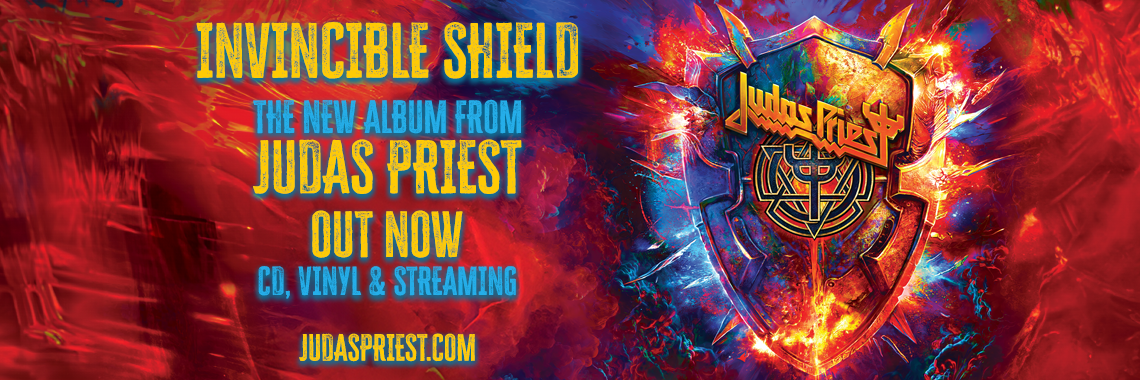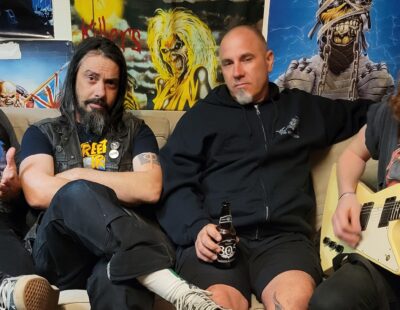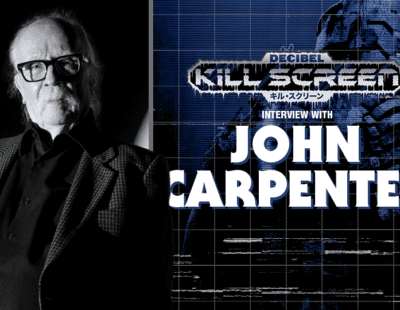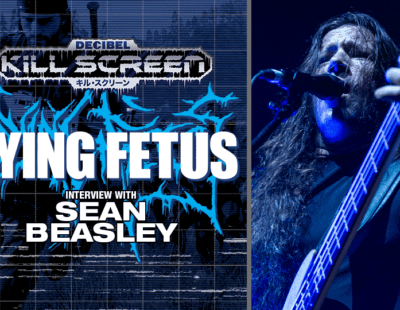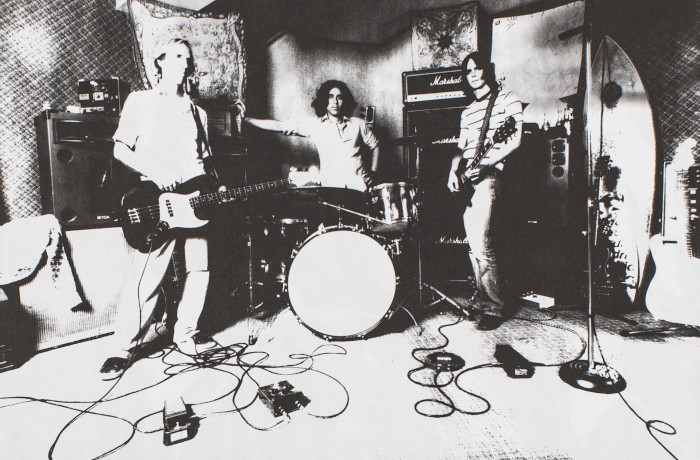
On Fu Manchu’s full-length bow, 1994’s No One Rides for Free, singer/guitarist Eddie Glass, bassist Mark Abshire, and drummer Ruben Romano began Nebula without even knowing it. Three years later, Abshire was long gone, and the other two had just bolted the Fu for Joshua Tree. Multi-colored vinyl reissues from Heavy Psych Sounds of Nebula’s big bang – 1997 EP Let It Burn, debut LP To the Center, and critical early comp Dos EPs – dust the history off a Nineties movement every bit as galvanizing as its root base: psych, punk, metal.
Decibel: Take us back to the two dudes who made Let it Burn, Nebula’s debut. Unless those memories have been reduced to haze.
Ruben Romano: No, they’re great memories, man, I gotta admit. Great memories. Comedy and drama, love and hate, all that stuff came together from the dismal situation of Eddie and I splitting with Fu Manchu. We turned that into, “Take your songs, Eddie, and take my lyrics for this and that, and let’s take our vibe out to that recording studio and not let anything stop us.” It was an exciting time because of that.
We were like, “Man, we’ve cut those ties that were holding us back on things we hoped to do.” It was an awesome moment in time. I was a bit of a spaz when I was young, just always, “What’s the next thing to do?” I tried to harbor that energy into what I brought into the whole thing, and it just kind of worked at that moment for us.
So you and Eddie end up in Joshua Tree.
That was part of that small community at that time. Fu Manchu and Kyuss, all of us had that desert connection happening out there. That was the mystical place at that time, like, “Rancho de la Luna, man, let’s cruise out there.” Luckily, we were able to get a couple of phone numbers, make some contacts, and schedule some stuff.
Really, it was on a whim. I think we called up there and said, “What are you guys doing this weekend?” Boom, all of a sudden we were driving to Joshua Tree. We just hit on full cylinders and went for it. At that time, that was one of the places, and it was also affordable because we were flat broke, so it kind of all worked in our favor. I know that the whole thing about the desert nowadays is so mystical and so profound and so, like, the birth of stoner rock, all that stuff, but at that time it wasn’t.
That was the start of the desert thing coming into focus for everyone. We got lucky. We were able to work with [Rancho co-owner] Fred Drake, who is unfortunately no longer with us, but we got lucky that we were able to actually do Let it Burn with him at the helm recording. It’s one of those things of being in the right place at the right time.
Did Joshua Tree feel exotic to you?
I was born here in Los Angeles County and also lived down south in Orange County and points in-between. For me, it’s like, “Yeah, get me out to the desert, man, where it’s open and free and traffic is not at all.” There’s a little of the country boy in me. I’m not the full-on city slicker that’s got to be in the city. Currently, I do not live in the heart of L.A. Where I live, it’s a good five miles to get to the nearest major freeway if I turn right, but if I turn left, in five minutes it feels like I’ve driven five hours out into the wilderness.
The EP is pretty raw. Listening to it, I’m thinking, “Does Eddie even know his mic is on?”
[Laughs] Yeah, we recorded that whole thing as live as we possibly could. Mark wasn’t in the band yet, so basically it was just Eddie and I. We couldn’t do everything live all at once, but everything we did was taken as live, if you will. We did drums and the rhythm guitar track at the same time to get that foundation, then we’d go in there and overdub it. At that time, there wasn’t even really computers, either. It was all tape.
Opening blast-off “Elevation” sounds like it could have gone on another five minutes at least, but it cuts off in under three. How much did the two of you have to reign in the jams?
Eddie had a lot of these songs demoed on his little porta studio four-track cassette multi-tracker thing, and you’re right, we didn’t have a lot of time to sit there and try to arrange it and see how huge we could get with it and how long we could expand it. The ideas he had were kind of short and sweet and to the point like that, so we kept true to the demos as far as arrangements and all that kind of stuff.
The original EP was six songs, and the reissue adds “Sonic Titan” and “Devil’s Liquid? Where are they from?
Basically there’s two releases of the EP prior to this new one. Tee Pee Records first released it and then it got picked up by Relapse Records. To give it a little something and to give them more to push, we gave Relapse those two songs. Mark had joined the band by then, recorded the other two songs with us, and we liked those two songs. Relapse gave us the opportunity to add those two songs onto it – introduce Mark into the band with it.
The reissue right now is like the Relapse version, with those extra two songs, and then we dug through the vaults to find an additional two extra bonus tracks. Mark jumped into the driver’s seat with these reissues. He was determined, like, “We gotta make these things look good.” He was like, “We gotta add extra things, because collectors are going to want something else.”
So then it’s a big jump from the EP to Nebula’s debut full-length, To the Center – on Sub Pop, no less. That’s a big label to be on in 1999.
Pretty big jump, and to tell you the truth, Sub Pop came and saved our asses big time in how the whole thing panned out and how we got connected with the label. It’s a pretty awesome tale.
The Tee Pee version of Let it Burn and the Relapse version of Let it Burn allowed us to do what we really wanted to do and that was hit the highway and tour. For me personally, that’s what I enjoyed the most, was hitting the road and playing live. Let it Burn gave us the opportunity to do that and that’s what got the three of us – Eddie, Mark, myself – really super tight. By the time we were ready to record To the Center, we were a pretty awesome, well-oiled machine. We had the tunes and we picked a couple covers, too, just because we liked those songs.
And it was supposed to come out on a completely different label….
We had signed to a label called Zero Hour, so we did a tour of Europe. We flew back to New York, and then from New York we drove across to Seattle, where we were supposed to start recording for Zero Hour. After two or three days of being in the studio, they just disappeared, phone disconnected and no contact, an almost missing persons case.
They had given us a good little bit of money to buy gear, so we all bought some mad gear and were ready to go in and record this record. So here we are with Seattle scene legend, [producer] Jack Endino, and all of a sidden we’re getting word from our manager at the time that, “Hey, man, we don’t know where this label is.” His office was in New York and the label was in New York, so even going to their storefront and their offices, the place was gutted. “There ain’t nobody there and nobody knows what the hell happened to them.”
Still to this day, I don’t know. It’s pretty crazy because we were already into the recording and when we found out there was no money coming in to pay for the studio, that’s when Jack was the coolest person. He goes, “You know what? Let’s finish this record and let’s worry about it later.” We were like, “Okay, Jack, let’s do that.”
Eddie was in this band called Olivelawn prior to joining Fu Manchu and they had a chance opportunity to be on Sub Pop. I think they took the stance of, “We’re more punk than you, so fuck Sub Pop,” and declined being on the label, I don’t know. But because of that, Eddie had a bit of a connection with them, so the first time we ever played in Seattle, people like Mark Arm and Ben Shepherd, and all those Sub Pop heavyweights actually attended our show and we got to know them a little.
In fact, before we even started To the Center, we were in Seattle and Mark Arm let us tighten up some stuff and rehearse in his basement. So this whole deal with Zero Hour goes down and Jack says, “Let’s just finish this record anyway, but you know what? Let’s go get some food first.” We go to the grocery store to get some apples and bananas, and Jack runs into Megan Jasper, who’s the CEO from Sub Pop, there in the grocery store.
“Hey Jack, what are you doing?” “I’m recording these guys.” “Who are these guys? “Oh, hey, I know that guy, Eddie.” It’s chance and destiny that lined us up with Sub Pop. They came in and said, “You guys aren’t going to stop recording, so let us sign you.” That’s how the whole thing happened. It’s like out of a movie. It was crazy.
Definitely some Stooges influence on Let It Burn, which is still there on To the Center, but now there’s New York Dolls in the mix as well on something like “Clear Light,” with its acoustic guitars and handclaps.
Yeah, you’re hitting two bands that were kind of big on our cassette players in the van as we were rolling along. That was one of the cool things about escaping the Fu Manchu hold, was we had a little bit of a broader like in music. Eddie and I, we enjoyed a lot of German prog stuff, and we enjoyed a lot of that New York punk glam era. We enjoyed all that heavy stuff from the ’60s, and we also enjoyed all that fuzzy stuff, via the Nuggets compilation.
Fu Manchu was more like, “No, man, we want to rock like AC/DC, Black Sabbath, blah blah blah.” It was like, “Great, perfect, perfect, man, but there’s all this other great music that’s inspiring me personally. Dude, listen to that fuzz sound on this,” but it’s a jangly, 12-string predominant song. It was like, “We don’t even want to listen to it.”
By splitting off and doing our own things, that’s when we were able to incorporate all those other influences we had musically, like the raga on Let It Burn. I think that’s why Nebula kind of stands apart from the typical stoner rock genre at the time. These reissues – with our influences – get a little something different in there. Whether it’s night and day or the completely opposite side of the spectrum, we tried to incorporate it all, and that was the fun part about being in this band together.
The band’s debut and then the first album are obvious as reissues. Then you’ve got Dos EPs, which is four songs from the Sun Creature EP coupled with another four songs from the Nebula/Lowrider split, both from 1999. That third title feels part of the big bang of the first two.
You’re right, because when those EPs were issued separately, they were the cheese in the middle of that sandwich. They were in between Let it Burn and To the Center, and then after To the Center is when they got smashed together and released as one whole. And it’s never been pressed on vinyl, plus it does encompass the entire time Mark was in the band, which lends the whole reissue anniversary a full-on OG members feel.
What are the first three songs on Dos EPs, “Rocket,” “Long Day,” and “Bardo Airways.” What are they from?
Those were recorded in the Hollywood Hills by a friend, Matthias Schneeberger. Everyone knows him as Schneebee. It’s similar to the “Sonic Titan” and “Devil’s Liquid” tracks. We knew Schneebee, we had these three songs, and we recorded them. Man’s Ruin had gone down and Meteor City wanted to do a new release, but we only had three songs at that moment. “Well, why don’t we reissue the Man’s Ruin, we’ll add these three, we’ll combine the two EPs, and we’ll make something that’s got the content, other than just, say, a three-song EP.”
The bonus tracks on that one are live. Has Nebula ever released a vintage concert recording?
We do have a plan. We’ve never released a live record. I think the only real live thing like that that we did was a bunch of BBC sessions ended up getting compiled into a release later on. As far as live performance, there’s always tapers taping shows and we had such a big vault of performances, so what we’re planning on doing isn’t necessarily, like, Nebula Live in Chicago or putting it down to one live performance. We also have a bunch of outtakes. We have a small handful of things that were never released, so we have a plan with Heavy Psych Sounds to maybe put out one more thing with Nebula’s original members, a compilation of live performances, outtakes, and unreleased material.
That was even more fun than going back and re-listening to all the records, was filtering through the live stuff. Again, Mark dove into it and he must just not want to hear anything live by Nebula for the longest time because he was the one who had most of the tapes and he was the one who was going through and picking the better performances here and there and all that kind of stuff. Every time he would come and throw something on the table after hours of filtering through stuff, I was like, “Man, you’re right, we did kick ass.” Hearing these live things, I’m enjoying this more than hearing the records after all this time.
It’s gratifying and I’m stoked Heavy Psych Sounds approached me with the idea to go and ask the guys and get everything all set in motion. That did kind of reunite us after all these years. And it never was an intention to get the three of us back together and restart the band as it was.
Eddie never really gave announcements that the band ever broke up, so basically he went into a hiatus all this time where he’s been absent from the scene. I think that given these reissues, maybe it’s what sparked a little fire under his feet, to, “Hey, I guess this is the time to come out of hiatus.” That’s why a bit of fan controversy happened, where the people looking to Nebula now that’s out of hiatus were misled by the the wrong term of “reunion.”
It’s not really a reunion. It’s just a return of Eddie getting his gears back into motion. It never was an intention to get the original members back together. It was more so just a celebration of what we accomplished.

